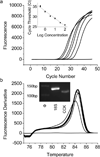Identification of mRNA for endocannabinoid biosynthetic enzymes within hippocampal pyramidal cells and CA1 stratum radiatum interneuron subtypes using quantitative real-time polymerase chain reaction
- PMID: 22609938
- PMCID: PMC3409849
- DOI: 10.1016/j.neuroscience.2012.05.012
Identification of mRNA for endocannabinoid biosynthetic enzymes within hippocampal pyramidal cells and CA1 stratum radiatum interneuron subtypes using quantitative real-time polymerase chain reaction
Abstract
The hippocampus is required for short-term memory and contains both excitatory pyramidal cells and inhibitory interneurons. These cells exhibit various forms of synaptic plasticity, the mechanism underlying learning and memory. More recently, endocannabinoids were identified to be involved in synaptic plasticity. Our goal was to describe the distribution of endocannabinoid biosynthetic enzymes within CA1 stratum radiatum interneurons and CA3/CA1 pyramidal cells. We extracted mRNA from single interneurons and pyramidal cells and used real-time quantitative polymerase chain reaction (RT-PCR) to detect the presence of 12-lipoxygenase, N-acyl-phosphatidylethanolamine-specific phospholipase D, diacylglycerol lipase α, and type I metabotropic glutamate receptors, all known to be involved in endocannabinoid production and plasticity. We observed that the expression of endocannabinoid biosynthetic enzyme mRNA does occur within interneurons and that it is coexpressed with type I metabotropic glutamate receptors, suggesting interneurons have the potential to produce endocannabinoids. We also identified that CA3 and CA1 pyramidal cells express endocannabinoid biosynthetic enzyme mRNA. Our data provide the first molecular biological evidence for putative endocannabinoid production in interneurons, suggesting their potential ability to regulate endocannabinoid-mediated processes, such as synaptic plasticity.
Copyright © 2012 IBRO. Published by Elsevier Ltd. All rights reserved.
Figures






Similar articles
-
Hippocampal Stratum Oriens Somatostatin-Positive Cells Undergo CB1-Dependent Long-Term Potentiation and Express Endocannabinoid Biosynthetic Enzymes.Molecules. 2019 Apr 3;24(7):1306. doi: 10.3390/molecules24071306. Molecules. 2019. PMID: 30987110 Free PMC article.
-
Expression of type I mGluRs predicts plasticity in the hippocampal stratum radiatum interneurons.Neurosci Lett. 2019 Nov 1;712:134472. doi: 10.1016/j.neulet.2019.134472. Epub 2019 Sep 6. Neurosci Lett. 2019. PMID: 31499135 Free PMC article.
-
Differential expression of GABA and glutamate-receptor subunits and enzymes involved in GABA metabolism between electrophysiologically identified hippocampal CA1 pyramidal cells and interneurons.Epilepsia. 2003 Feb;44(2):143-9. doi: 10.1046/j.1528-1157.2003.06102.x. Epilepsia. 2003. PMID: 12558566
-
Cell-type specific GABA synaptic transmission and activity-dependent plasticity in rat hippocampal stratum radiatum interneurons.Eur J Neurosci. 2005 Jul;22(1):179-88. doi: 10.1111/j.1460-9568.2005.04207.x. Eur J Neurosci. 2005. PMID: 16029207
-
Endocannabinoid system in the neurodevelopment of GABAergic interneurons: implications for neurological and psychiatric disorders.Rev Neurosci. 2021 Mar 30;32(8):803-831. doi: 10.1515/revneuro-2020-0134. Print 2021 Dec 20. Rev Neurosci. 2021. PMID: 33781002 Review.
Cited by
-
Hippocampal Stratum Oriens Somatostatin-Positive Cells Undergo CB1-Dependent Long-Term Potentiation and Express Endocannabinoid Biosynthetic Enzymes.Molecules. 2019 Apr 3;24(7):1306. doi: 10.3390/molecules24071306. Molecules. 2019. PMID: 30987110 Free PMC article.
-
Chronic atrazine exposure increases the expression of genes associated with GABAergic and glutamatergic systems in the brain of male albino rat.Front Toxicol. 2022 Aug 22;4:933300. doi: 10.3389/ftox.2022.933300. eCollection 2022. Front Toxicol. 2022. PMID: 36071823 Free PMC article.
-
Chronic Δ9-tetrahydrocannabinol impact on plasticity, and differential activation requirement for CB1-dependent long-term depression in ventral tegmental area GABA neurons in adult versus young mice.Front Neurosci. 2023 Jan 9;16:1067493. doi: 10.3389/fnins.2022.1067493. eCollection 2022. Front Neurosci. 2023. PMID: 36699526 Free PMC article.
-
Ventral tegmental area dopamine and GABA neurons: Physiological properties and expression of mRNA for endocannabinoid biosynthetic elements.Sci Rep. 2015 Nov 10;5:16176. doi: 10.1038/srep16176. Sci Rep. 2015. PMID: 26553597 Free PMC article.
-
α6 subunit-containing nicotinic receptors mediate low-dose ethanol effects on ventral tegmental area neurons and ethanol reward.Addict Biol. 2018 Sep;23(5):1079-1093. doi: 10.1111/adb.12559. Epub 2017 Sep 13. Addict Biol. 2018. PMID: 28901722 Free PMC article.
References
-
- Abush H, Akirav I. Cannabinoids Modulate Hippocampal Memory and Plasticity. Hippocampus. 2010;20:1126–1138. - PubMed
-
- Alger BE, Pitler TA. Retrograde signaling at GABAA-receptor synapses in the mammalian CNS. Trends Neurosci. 1995;18:333–340. - PubMed
-
- Ascoli GA, Alonso-Nanclares L, Anderson SA, Barrionuevo G, Benavides-Piccione R, Burkhalter A, Buzsaki G, Cauli B, Defelipe J, Fairen A, Feldmeyer D, Fishell G, Fregnac Y, Freund TF, Gardner D, Gardner EP, Goldberg JH, Helmstaedter M, Hestrin S, Karube F, Kisvarday ZF, Lambolez B, Lewis DA, Marin O, Markram H, Munoz A, Packer A, Petersen CC, Rockland KS, Rossier J, Rudy B, Somogyi P, Staiger JF, Tamas G, Thomson AM, Toledo-Rodriguez M, Wang Y, West DC, Yuste R. Petilla terminology: nomenclature of features of GABAergic interneurons of the cerebral cortex. Nat Rev Neurosci. 2008;9:557–568. - PMC - PubMed
-
- Bacci A, Huguenard JR, Prince DA. Long-lasting self-inhibition of neocortical interneurons mediated by endocannabinoids. Nature. 2004;431:312–316. - PubMed
Publication types
MeSH terms
Substances
Grants and funding
LinkOut - more resources
Full Text Sources
Miscellaneous

